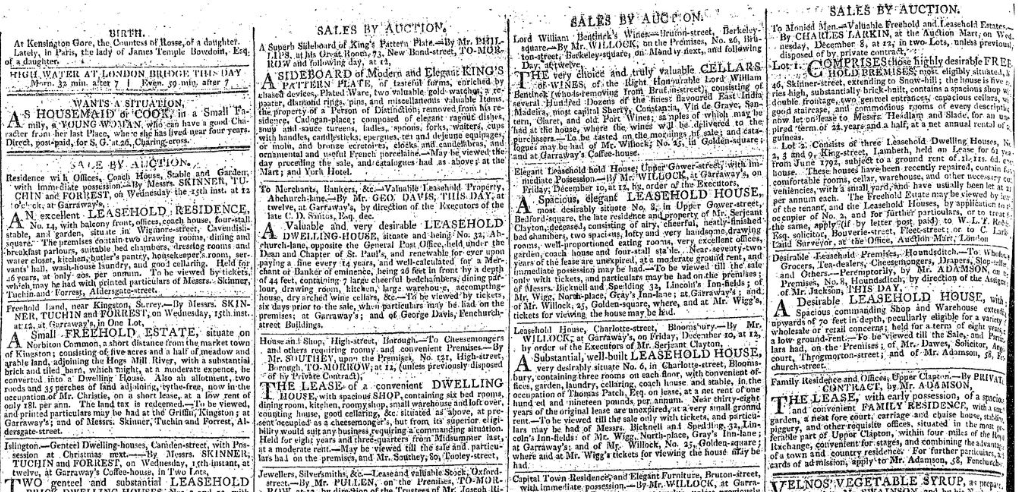| By Jennifer Albers-Smith |
I took this awesome class in college at the University of Michigan that—10 years later—still resonates with me. It focused exclusively on Jane Austen and her contemporaries. We read all of Austen’s novels as well as Radcliffe, Burney, and Wollstonecraft, and it was easily the best four months of my academic career. The professor was really innovative and brought in one of her colleagues, Kathryn Dominguez, from the Economics department to do a lecture on what things cost in Jane Austen’s time. She put together this great PowerPoint deck that I still have to this day because I thought it was so intriguing.
Numbers pop up all the time in Austen’s novels, but the reader really has no sense of how rich Bingley and Darcy are or how “poor” the Bennets are by comparison.
Because Economics is by no means my strength, I naturally assumed it was easy to figure out how much Mr. Darcy’s 10,000 per year really is in 2014. It turns out it isn’t. Professor Dominguez said that there is no single correct way to determine the relative value of an amount of money in one year compared to another and that most approaches to this problem attempt to measure the price of a “bundle” of goods and services that a representative group buys or earns. They then compare that cost of the bundle in one year to the cost in another year.
So calculating purchasing power for the early 1800s is no exact science, but there is a website (no surprise there!) that allows us to get an estimate for purchasing power in 1813 (when Pride and Prejudice was published).
So, in today’s dollars, just how much is Darcy worth? £569,300.00 per year! And how much is that in U.S. dollars? $966,966! Yeah, Darcy was loaded.
And that was just the 4 percent interest Darcy derived from his investments, not the rents from his estates. His actual inheritance/net worth would have been much greater. No wonder Mrs. Bennet was so excited. And Bingley wasn’t exactly poor either, at 4,000 pounds per year, or $386,684 yearly in 2014. Not many people can say they make that much per year – and just on interest.
To further explore this quandary, I went into Gale NewsVault and pulled out some advertisements placed in 1813 to give us an idea of what other things cost when Pride and Prejudice came out. I limited my search to January 1, 1813-December 31, 181,3 and selected just advertisements.
“SUNDAY AND TUESDAY’S POST.” Jackson’s Oxford Journal [1809], January 2, 1813. British Library Newspapers (accessed February 12, 2025). https://link.gale.com/apps/doc/Y3202647048/GDCS?u=gale&sid=bookmark-GDCS&xid=e2786371.
Room and board at the Ladies’ Seminary in Adderbury costs 18 pounds 18 shillings per annum, with an additional 2 pounds 2 shillings for washing, and the same for French and “Use of the Globes”, which I’m assuming means some sort of geography lessons. That comes to a total of 24 pounds 24 shillings per annum. Using the above website and a currency converter, that comes to $2,437 per annum. I’m pretty positive boarding school today comes nowhere near that price. That amount might cover school supplies – maybe. This would seem to suggest that a woman’s education was a lot cheaper back in 1813.
And a house for rent with a dining and breakfast parlor and servants’ quarters runs at 46 pounds, 2 shillings per annum, which using our calculator and currency converter comes to 2,625 pounds or $4,457 per annum, which comes out to $371 per month. Seems like a pretty good deal to me!
“Advertisements & Notices.” Morning Chronicle [1801], December 1, 1813. British Library Newspapers (accessed February 12, 2025). https://link.gale.com/apps/doc/BA3207120786/GDCS?u=gale&sid=bookmark-GDCS&xid=7eeee64b.
I could spend all day looking through Nineteenth Century UK Periodicals, Part 1: Women’s, Children’s, Humour, and Leisure browsing advertisements. It’s utterly fascinating. Every time I spend more time looking through old newspapers, I can’t help but want to learn more!
About the Author
Jennifer loves her children, dogs, and Jane Austen. She has a B.A. in English and Sociology from the University of Michigan, and spends her waking hours as a marketing director and feeding her family.




This is such an interesting perspective about 19th century life. I love the comparisons with contemporary life. Fascinating.
Just how “poor” were the Bennett’s?
Mr. Darcy owned a large estate with woodlands, farm land, waterways, and gardens. The house was very nearly a castle. His income was estimated to be 10,000 pounds a year, maybe more.
Mr. Bingley was considered wealthy, and his income was estimated at only 5,000 a year.
That was quite a chunk of annual income in the days when a family of seven, like the Bennetts, could live on 2,000 a year and still afford to dress decently, travel in a limited way, keep servants and a country estate, and set a fine table. Admittedly, five unmarried daughters did stretch their father’s income, and none of the girls had a meaningful dowry. But they were living in genteel but limited circumstances, not hopeless poverty. They were not destitute, but were sometimes financially pressed.
Clearly, though, they all knew they could not afford Lydia’s selfish idiocy or Wickham’s perfidy without the aid of Mrs. Bennet’s successful brother — or, as it turned out, from Mr. Darcy. Buying Wickham to save Lydia’s honor would have left Mr. Bennett bankrupt, even though not salvaging Lydia’s name and reputation would have ruined any chance the four other sisters had of making good marriages. Lydia’s ruin would have sullied the reputations of her sisters and their entire family. .
The problem with estimating Darcy’s wealth is that we live in a consumer/consumables economy, whereas they lived in a service economy, so a straight rate-of-exchange doesn’t begin to cover actual buying power within the world Austen lived in. However, if you take the rate paid to a full-time manual laborer in Austen/Darcy’s time, compared with a minimum wage in our time, Darcy has around $7 million per year. Yet, presumably, the wages they paid laborers was actually enough to live off by fairly, whereas the minimum wage today is far below what you’d need to get by. So, if you increase the minimum wage to something actually liveable nowadays, which recent studies say would be around $22 per hour (the hourly rate needed to rent a 2 BR apartment), that would mean the worth of Darcy’s 10,000 would be comparable to over $20 million per year. You can easily see how that pans out as it would explain his extravagant manor, artworks, library, musical instruments, acreage, servants enough to care for all of that, — and his flakey childhood friend(s).